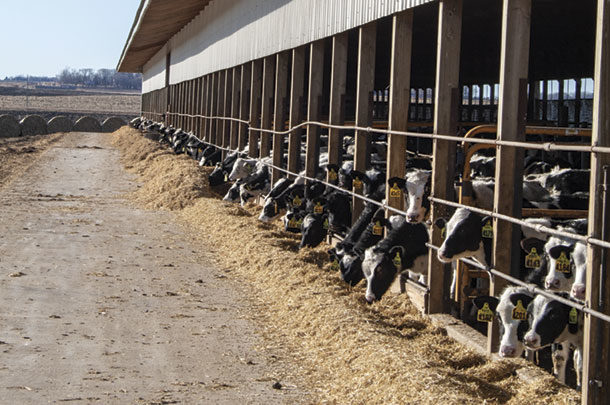Digital dermatitis, also referred to as “hairy heel warts,” produces painful lesions that can lead to lameness in cows, ultimately resulting in decreased milk production and lowered reproductive performance.
The dairy industry has been researching digital dermatitis for more than 40 years, yet we are still researching and answering many outstanding questions. Clinical lesions have been well described, but more research is needed to know about the morphological changes associated with the initial stages of lesion development from normal skin to clinical lesions.
Dairy heifers appear to be most susceptible to digital dermatitis infections around puberty, and heifers that have warts can potentially experience digital dermatitis for life. On the other hand, heifers that don’t experience warts in the growing period are at less risk of developing lesions during their first lactation.
Heifers that had one or more incidences of digital dermatitis between breeding and calving had a 45.6% and 67% chance, respectively, of developing digital dermatitis during first lactation. Heifers that had no incidences of digital dermatitis had just a 13.7% chance.
To develop and run rampant, digital dermatitis needs bacteria, primarily a spirochetal species of anaerobic bacteria known as treponema. Treponemes can be found on healthy skin, but they need moisture to grow and require compromised skin integrity to enter the body. Treponema thrives in a low-oxygen environment, making manure slurry a good skin conditioner for priming a point of entry for digital dermatitis to take hold.
Controlling and preventing digital dermatitis in heifers is essential. Once the disease is introduced to the herd, it spreads rapidly, and prevalence is observed in a high percentage of animals. Heifers that develop digital dermatitis in the growing phase are often given a “life sentence” due to the nature of the hoof disease and the difficulty of treating chronic lesions once they are established in the cows.
Multiple digital dermatitis incidences impact reproduction and milk production
There is a strong correlation between digital dermatitis and heifer reproductive performance. Heifers with multiple incidences of digital dermatitis experienced a first-service conception rate during the first lactation of just 29%, while heifers that had no incidences of digital dermatitis had a 42% first-service conception rate in their first lactation. Cows with multiple incidences of digital dermatitis also had more days open (157 versus 132) than those that had no digital dermatitis events.
Heifers that had incidences of digital dermatitis also had significantly lower milk production during first lactation. Animals with one incidence lost 439 pounds (199 kilograms) of milk, while those with multiple incidences lost 738 pounds (335 kilograms). Regardless of digital dermatitis infection, all heifers supplemented with performance trace minerals produced an additional 423 pounds (192 kilograms) of milk compared to heifers receiving inorganic trace minerals.
Trace minerals minimize effects of digital dermatitis
Trace minerals are essential for developing a strong immune system and reproductive tract, maintaining skin and claw integrity, and boosting the cow’s ability to perform and resist diseases like digital dermatitis. Research has shown that certain trace minerals, when fed in conjunction with a specific digital dermatitis formula in a dairy heifer ration, improve hoof and skin integrity, decreasing the incidence of digital dermatitis and improving overall heifer wellness and performance.
Reducing the prevalence of digital dermatitis will also positively influence milk production and cow reproductive performance. Research shows that heifers fed performance trace minerals starting at six months pre-calving had increased milk production and growth efficiency. By reducing the prevalence of digital dermatitis, the performance trace minerals also helped improve reproductive performance.
Digital dermatitis control successful when started early
There are three important components to be considered when controlling digital dermatitis in replacement heifers:
- Dairy operation management must enforce biosecurity principles to keep infected animals from entering the herd. Early and regular inspection of hooves on heifers and prompt treatment of any cow hoof problems will reduce the occurrence of chronic lesions, which become a source of further infection.
- Maintaining a clean, dry environment and the use of well-designed footbaths as needed reduces stress on the skin to prevent infections. Additional manure removal and reduced crowding (stocking density) can often have very positive impacts on foot hygiene.
- Nutrition plays a key role in preventing digital dermatitis during all growth phases. Incorporating important trace minerals into the dairy heifer nutrition plan can be a part of an integrated prevention and control strategy that provides health benefits later in the cow’s productive life.
As we learn more about how digital dermatitis infects and spreads through a herd, it becomes clear that an integrated prevention and control strategy can be successful when started early in an animal’s life.







